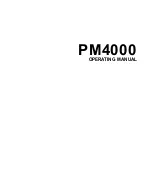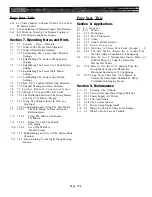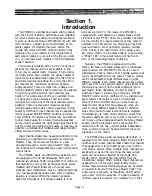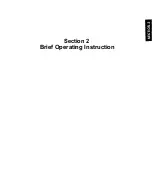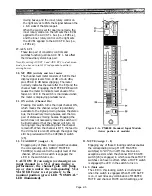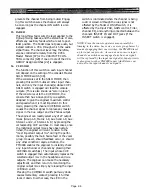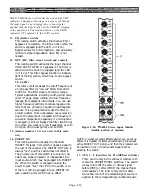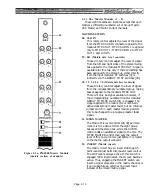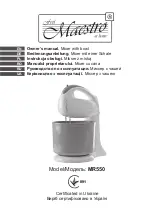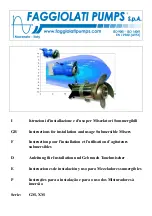
stereo master output. Cue replaces the signal in the
headphones and the stereo cue XLR outputs with only
those sources whose CUE switches are engaged.
The CUE system has input priority so that the
operator may normally monitor the cue signal from the
stereo bus or the group busses, and can instantly check
one or more channel or aux return inputs without
having to first release the bus CUE switches. This
capability is great for troubleshooting, previewing a
channel before applying it to the mix, or “touching up”
the EQ on a channel during a performance. For use
ahead of a live show, the console may be placed in solo
mode. In this mode, only the input channel(s) whose
CUE/SOLO switch is engaged will feed the console’s
outputs, and all other input channels will be muted. If
the stereo input modules are used for returns, recessed
switches in these modules can be set so returns will not
be muted and any effects applicable to the soloed input
will be heard. Annunciator lights signal the operator
whether the console is in solo or cue mode, and whether
any CUE or CUE/SOLO switch is engaged. Two head-
phone jacks enable a pair of console operators (or an
engineer and producer) to work side-by side on complex
projects.
The PM4000 has an excellent talkback system plus
a useful test oscillator. An XLR input (with phantom
power) can be set to accept any microphone or line level
input, and is activated with the TALKBACK switch.
That signal can be slated to any of the eight group
mixing busses, the eight aux send mixing busses, the
two stereo aux busses, the stereo mixing bus, and to a
rear panel XLR TB output. The test oscillator can be set
to 100 Hz, 1 kHz or 10 kHz fixed frequencies, or can be
swept from 0.2 to 2x the set frequency, and its output
level is adjustable. Pink noise may be selected, too. The
oscillator can be slated to the same busses as the
talkback, and also has its own rear panel output connec-
tor so the signal can be routed to other equipment or
other console inputs for testing.
Extensive metering is provided with a total of 14 VU
meters on the 24 and 32 channel versions, or 18 VU
meters on the 40 and 48 channel versions (each with a
peak LED). Several of these meters can be switched to
monitor alternate busses, so the metering gives you a
comprehensive view of signal levels in your system.
PM4000 electronic performance is everything you’d
expect from the people who developed the PM3000. It is
even more advanced, with lower noise levels than ever.
Wide headroom throughout, exceptionally low distor-
tion, and quiet controls are the hallmark of this top
quality mixing console. The specifications are honest
and conservative. The performance is audibly superb.
Physically, the PM4000 is as appealing as it is
electronically. An all new chassis design with aircraft-
style bracing offers increased strength to sustain
repeated trips on the road. A gray finish and subtly
color coded controls set the backdrop for the PM4000’s
hundreds of illuminated switches and indicators.
Multiple rear-mounted cooling fans reduce internal
temperatures to prolong component life.*
The highly advanced PM4000, with its many inter-
nally switchable functions, is as close to a custom
console as you can get... while retaining all the value
and reliability of an off-the-shelf Yamaha console. While
its numerous internal and front panel functions may at
first intimidate the casual console operator, the PM4000
is actually a very straightforward console to use.
Anyone who has used the PM3000, or even a PM2000,
should immediately feel comfortable with the PM4000.
Take a while to study the panel, read the descriptions in
this manual, and you’ll find operating this console is
very natural... and satisfying because you can make it
do the job the way you need it done.
*Heat is generated by electronic components, and is the
enemy
of
them. In some segments
of the.
industry (such
as Las Vegas showrooms), it has been customary to leave
equipment switched on 24 hours. This tradition grew out
of the
days when vacuum tube equipment was prevalent,
and vacuum tubes did last longer
if
they remained on
rather than being switched. Solid state devices used in
modern mixing consoles are less susceptible to damage
from switching, but the heat build up sustained in
continuous 24 hour operation will shorten component
life. Therefore, it’s a good idea to turn off your equipment
when it is not in use (unless you are in a very humid
environment where the heat
of
operation wards off
corrosion-causing, short-circuit-promoting moisture
condensation). While the PM4000 remains cooler than
its predecessors, thanks to cooling
fans,
it remains a
prudent practice to shut it off when it is not being used.
Figure 1-2. PM4000-48 Rear Panel
Page 1-3
Содержание PM4000
Страница 1: ...PROFESSIONAL AUDIO MIXING CONSOLE PM4000 OPERATING MANUAL YAMAHA ...
Страница 2: ...PM4000 OPERATING MANUAL ...
Страница 7: ...Section 1 Introduction ...
Страница 11: ...Section 2 Brief Operating Instruction ...
Страница 47: ...Section 3 Specifications ...
Страница 51: ...Dimensional Drawings PM4000 Console all versions Page 3 4 ...
Страница 52: ...Page 3 5 ...
Страница 53: ...Page 3 6 PM4000 Console Rear Profiles ...
Страница 54: ...Module Block Diagrams See back of the manual for overall system block diagram Page 3 7 ...
Страница 55: ...Page 3 8 ...
Страница 56: ...Page 3 9 ...
Страница 57: ...Page 3 10 ...
Страница 58: ...Page 3 11 ...
Страница 59: ...Page 3 12 ...
Страница 60: ...Section 4 Installation Notes ...
Страница 72: ...Figure 4 13 Cables For Use With Balanced Sources Page 4 12 ...
Страница 79: ...SECTION 5 Gain Structure and Levels ...
Страница 82: ...Figure 5 1 Dynamic Range and Headroom in Sound Systems Page 5 3 ...
Страница 86: ...Section 6 Optional Functions ...
Страница 106: ...Section 7 Operating Notes and Hints ...
Страница 119: ...Section 8 Applications ...
Страница 124: ...Figure 8 3 System Diagram For 5 Independent Stereo Output Mixes via the Stereo Bus and the Mix Matrix Page 8 5 ...
Страница 127: ...Section 9 Maintenance ...
Страница 131: ......
Страница 132: ...YAMAHA VN02300 ...


